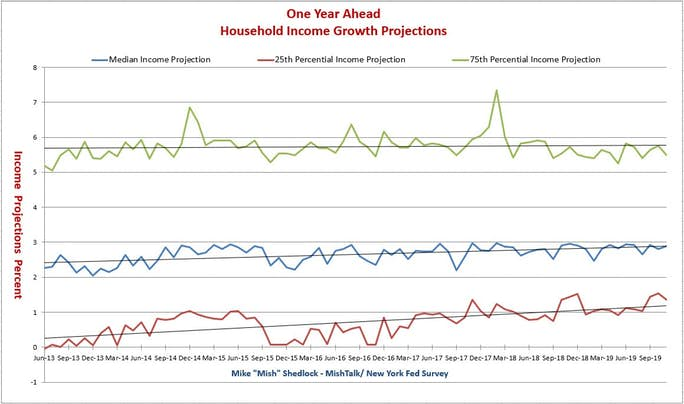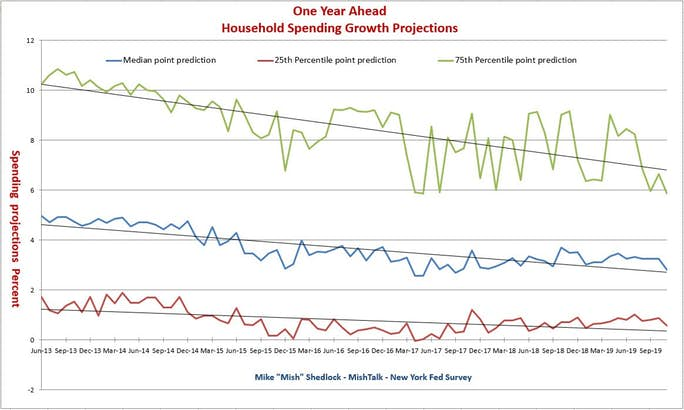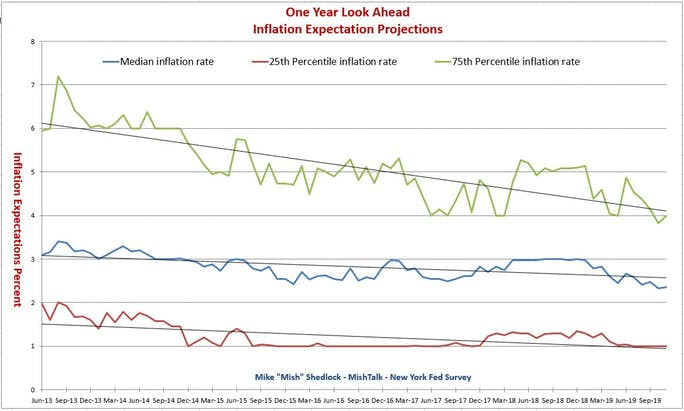
Every month the New York Fed does a survey of household expectations. Let's take a look at the findings.
Earlier today, the New York Fed released its Survey of Consumer Expectations for November. It provides one year look ahead projections for numerous items and three year look ahead expectations for inflation.
The November survey shows that median three-year-ahead inflation expectations increased by 0.1 percentage point to 2.5 percent, rebounding from a series low of 2.4 percent in October. While remaining optimistic about the labor market, consumers lowered their expectations for spending growth over the next twelve months, with the median estimate dropping to 2.8 percent—the lowest reading since September 2017. The decline was broad-based across age, income, and education groups.
The NY Fed charts are lame so I created my own charts.
One Year Ahead Household Income Expectations
What You See is What You Expect
The median household expects to make 2.9% more a year from now.
This is believable because wages of All Private Nonfarm workers rose from $27.43 to $28.29, a gain of 3.1% as noted in Jobs Surge in Strike-Ending and Seasonal Adjustment Rebound.
This is a clear cases of what you see is what you expect.
One Year Ahead Household Spending Expectations
Consumers Tapped Out
The median household expects to spend 2.8% more a year from now.
The trendline of spending projections vs income expectation is interesting. It makes sense to me. Consumers are tapped out.They want to spend less, but they barely expect to.
Inflation Expectations
The median person in the survey expects the CPI to rise 2.35% in the next year.
Surprising Result
I find this surprising.
Do these survey participants parrot Fed projections? Did the Fed give them a lecture as to how to calculate inflation?
Curiously, the projections seems reasonably accurate, at least as the BLS measures things.
However, my expectation would be the average person notices and complains about every price hike while forgetting about price decreases, especially in relation to food and gas.
Regardless, this is complete silliness.
Inflation Expectations are Nonsense
The purpose of this measurement coincides with the preposterous idea that spending decisions are predicated on inflation expectations.
Under this potty and observably wrong idea, consumers will hold back buying things if they expect prices to fall.
Thus, the Fed takes these measures seriously. In nearly every interest rate decision we see a comment along the lines of "inflation expectations are well anchored".
This is my reply.
Stupidity Well Anchored
Please consider Stupidity Well Anchored: Absurdity of Inflation Expectations in Graphic Form
The idea behind inflation expectations is that if consumers think prices will go down, they will hold off purchases and the economy will collapse. The corollary is that is consumers think inflation will rise, they will rush out and buy things causing the economy to overheat.
Let’s have a Q&A. I believe the answers are obvious in all cases.
Inflation Expectations Q&A
Q: If consumers think the price of food will drop, will they stop eating out?
Q: If consumers think the price of food will drop, will they stop eating at home?
Q: If consumers think the price of natural gas will drop, will they stop heating their homes?
Q: If consumers think the price of gas will drop, will they stop driving or not fill up their car if it is running on empty?
Q: If consumers think the price of gas will rise, can they do anything about it other than fill up their tank more frequently?
Q: If consumers think the price of rent will drop, will they hold off renting until that happens?
Q: If consumers think the price of rent will rise, will they rent two apartments to take advantage?
Q: If consumers think the price of plane tickets, taxis, and bus tickets will drop, will they hold off taking the plane the train or the bus?
Q: If consumers think the price of plane tickets, taxis, and bus tickets will rise, will they rush out and buy multiple tickets driving the prices even higher up?
Q: If people need an operation, will they hold off if they think prices might drop next month?
Q: If people need an operation, will they have two operations if they expect the price will go up?
All of the above questions represent inelastic items. Those constitute 80.254% of the CPI. Commodities other than food and energy constitute the remaining 19.746% of the CPI. Let’s hone in on that portion with additional Q&A.
Q. If someone needs a refrigerator, toaster, stove or a toilet because it broke, will they wait two months if for some reason they think prices will decline?
Q. If someone does not need a refrigerator, toaster, stove or a toilet will they buy one anyway if they think prices will jump?
Q. The prices of TVs and electronics drop consistently. Better deals are always around the corner. Does that stop people from buying TVs and electronics?
Q. If people thought the price of TVs was about to jump, would they buy multiple TVs to take advantage?
For sure, some people will wait for year-end clearances to buy cars, but most don’t. And if a car breaks down, consumers will fix it immediately, they will not wait for specials.
The only thing that’s “well anchored” is the stupidity of the belief that inflation expectations matter.
Economic Challenge to Keynesians
Of all the widely believed but patently false economic beliefs is the absurd notion that falling consumer prices are bad for the economy and something must be done about them.I have commented on this many times and have been vindicated not only by sound economic theory but also by actual historical examples.
- My article Deflation Bonanza! (And the Fool’s Mission to Stop It) has a good synopsis.
- My Challenge to Keynesians “Prove Rising Prices Provide an Overall Economic Benefit” has gone unanswered.
There is no answer because history and logic both show that concerns over consumer price deflation are seriously misplaced.
BIS Deflation Study
The BIS did a historical study and found routine deflation was not any problem at all.**“**Deflation may actually boost output. Lower prices increase real incomes and wealth. And they may also make export goods more competitive,” stated the study.
It’s asset bubble deflation that is damaging. When asset bubbles burst, debt deflation results.Central banks’ seriously misguided attempts to defeat routine consumer price deflation is what fuels the destructive asset bubbles that eventually collapse.
For a discussion of the BIS study, please see Historical Perspective on CPI Deflations: How Damaging are They?
Finally, and as a measure of insurance against the Fed’s clueless tactics, please consider How Much Gold Should the Common Man Own?
This material is based upon information that Sitka Pacific Capital Management considers reliable and endeavors to keep current, Sitka Pacific Capital Management does not assure that this material is accurate, current or complete, and it should not be relied upon as such.
Recommended Content
Editors’ Picks
GBP/USD stays below 1.2450 after UK employment data

GBP/USD trades marginally lower on the day below 1.2450 in the early European session on Tuesday. The data from the UK showed that the ILO Unemployment Rate in February rose to 4.2% from 4%, weighing on Pound Sterling.
EUR/USD steadies above 1.0600, awaits German ZEW and Powell speech

EUR/USD is holding above 1.0600 in the European morning on Tuesday, having hit fresh five-month lows. The pair draws support from sluggish US Treasury bond yields but the rebound appears capped amid a stronger US Dollar and risk-aversion. Germany's ZEW survey and Powell awaited.
Gold price holds steady below $2,400 mark, bullish potential seems intact

Gold price oscillates in a narrow band on Tuesday and remains close to the all-time peak. The worsening Middle East crisis weighs on investors’ sentiment and benefits the metal. Reduced Fed rate cut bets lift the USD to a fresh YTD top and cap gains for the XAU/USD.
SOL primed for a breakout as it completes a rounding bottom pattern

Solana price has conformed to the broader market crash, following in the steps of Bitcoin price that remains in the red below the $65,000 threshold. For SOL, however, the sensational altcoin could have a big move in store.
Key economic and earnings releases to watch

The market’s focus may be on geopolitical issues at the start of this week, but there is a large amount of economic data and more earnings releases to digest in the coming days.


